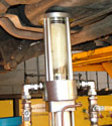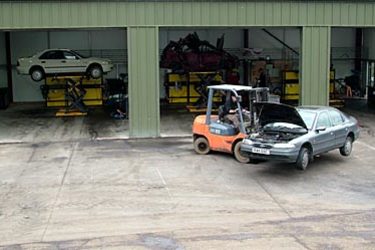HIGH VOLUME VEHICLE DRAINAGE
A quick and simple system for effective de-polluting of End of Life Vehicles(ELV). The Vehicle De-pollution Unit (VDU) provides a packaged solution for removing all the required fluids from an ELV and pumping them to a fluid storage facility. The unit integrates a 3T scissor lift to access the underside of the vehicle, although it can be used with a static frame.
All the extraction probes for the engine compartment activity are mounted on the elbow of the right-hand arm adjacent to where the engine compartment sits. The probes are connected to the VDU by high quality coil hoses which are guaranteed not to kink for ease of use.
The operator can drain the reservoirs with the minimum of physical movement ensuring maximum time efficiency.
Each fluid has its own pumping circuit which both extracts the fluid and then pumps it away to a storage facility. Operation of the pump is made clear by using a mixture of colours, graphics and text adjacent to each pump valve.

Once the engine compartment reservoirs are empty the vehicle is raised to a height appropriate for the reach of the operator - shorter workers will require the vehicle lower than taller people, a feature not possible with fixed platform installations.
Once at the required height the lift is mechanically locked in position eliminating any danger of a hydraulic failure causing the vehicle to change position when the operator is underneath.
Sump and gearbox oil are drained into the two large funnels mounted on the right-hand arm. Each funnel swings independently to ensure both can be drained at the same time. A similar funnel is mounted at the back for the rear differential. The radiator is drained by introducing a hollow spike into the lower radiator hose. The spike is mounted on the end of the arm with the funnels to again, minimise operator movement.
Brake cylinders are emptied by connecting onto the front bleed nipples.
On cars with under body fuel tanks, fuel is extracted by piercing the tank with our unique fuel extraction tool. The tool seals to the bottom of fuel tank preventing fluid or vapours escaping during the extraction process. The fuel drains into the inspection glass allowing the operator to grade the quality of the fuel.
Dirty or contaminated fuel can be sent to a separate tank from clean fuels. The system has several safe guards to ensure the operator distinguishes between Petrol and Diesel. Clean Petrol and Diesel are sent to separate tanks, each having its own fuel filter mounted in the pipework capable of removing particles down to 5 micron and removes water from the fuel should the operator make a mistake.
For vehicles where it is either not possible or desirable to puncture the tank the system includes a siphon pipe for extracting fuel out of the filler pipe.
Using a scissor lift which picks up just on the sills ot the vehicle allows the operator full access to all the operating parts of the vehicle access to remove the Catalytic converter as well as the opportunity to strip parts.
Once de-pollution is complete the car is lowered and removed by fork lift truck.

The system is capable of separately extracting all the individual fluids, it is then the operators choice as to how the fluids are stored.
Our typical tank farm would have 6 tanks individually storing Petrol, Diesel, Dirty Fuel, Engine oils, Hydraulic oil and Engine waters. The Petrol and Diesel tanks would typically have dispensing pumps to dispense the fuel directly back into the owners vehicles.
The minimum number of tanks is typically 3 for Clean Petrol, then all the oils, Diesel, Dirty fuel and Hydraulic oils go into the second tank and engine waters go into the third.



The most we heave done is 8 tanks system similar to our standard 6 tank arrangement but where the engine waters have been split into 3 separate tanks for Wind shield wash, Red anti freeze coolant and Green Anti freeze coolant. These clients have separate markets for these various water based fluids increasing their return.
The system gives you the choice and where fluids are combined in the initial installation they can always be split as the legislation or market develops.
Typical processing times are 10-12 minutes per vehicle, however we would generally work on one bay processing 30 cars per day with one operator.
The VDU provides the most modern approach to vehicle de-pollution.
The system is modular in that any number of VDU bays can be piped upto a single fluid storage facility.



